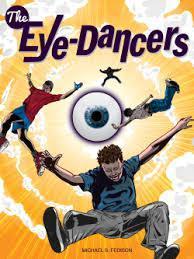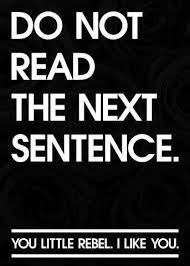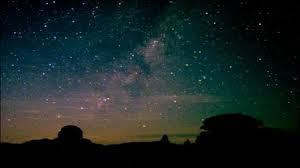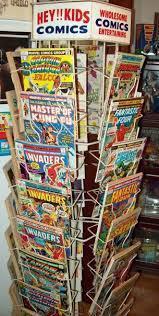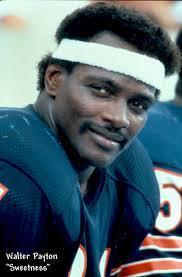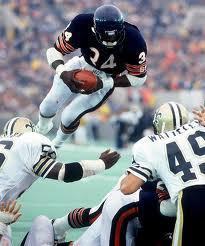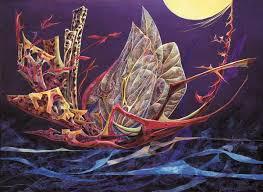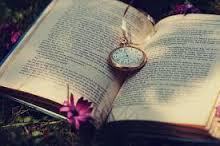Michael S. Fedison's Blog, page 15
April 23, 2015
A Literary Lemonade Stand–Or, An Old Promo with a New Twist
When I was eleven years old, I had a great (or so I thought) idea for a promotion.�� School had just let out, and I wanted to earn some spending money for summer vacation.�� So–I pitched my idea to my next-door neighbor Rick.
“Hey,” he said, no doubt visualizing the games and comic books and other assorted sundries his share of the profits might buy, “that sounds great.�� Count me in!”
There were no two ways about it–Rick, with his sandy hair and dimples, had a face few could resist.�� His cheeks were perpetually red from the pinches he’d get from adults.�� With his help, I was sure we’d be a hit.
Our plan?�� On the upcoming Saturday, we’d set up a stand at the base of his front lawn, strategically shaded by the towering maple tree that grew there like a leafy sentinel.�� We’d been in the midst of a heat wave.�� Surely passersby and motorists would stop for a cup of the lemonade we’d offer–both classic and pink!�� We’d also have apple juice, a sheet cake Rick’s mother agreed to make, sliced into two-dozen pieces, and a cooler-full of Popsicles.�� It was a can’t-miss proposition.�� Rick and I were convinced no two kids had ever been more prepared to run a lemonade stand.�� We even made signs, complete with the address and date of the event, which we placed at various strategic locations throughout the neighborhood.
We’d charge a quarter a cup for the lemonade and juice, a quarter per Popsicle, and one dollar for each slice of cake.�� Who would pass that deal up on a sparkling summer day, with the birds singing and the breeze blowing softly through the trees?
The day before our big sale, Rick popped in for a visit and did a “cha-ching” dance–his own, on-the-spot invention.�� This was greeted with catcalls from my two older brothers, but we were undeterred.
My mother sent us an ominous warning, however.
“It’s supposed to rain tomorrow,” she said.
Uh-oh.�� We hadn’t even bothered to check the forecast.�� So much for our sparkling day . . .
Twenty-four hours later, Rick and I were seated behind our lemonade stand–which was not so much the stand we had envisioned but rather the picnic table, complete with umbrella, that my brothers and I had managed to carry out to Rick’s front lawn and which now shielded our merchandise from the torrential downpour that would not let up for the entire day.
When all was said and done, we made twelve dollars and change that soggy Saturday–not the fortune we had hoped for.
“Well, at least there’s leftover cake,” my sister said happily as we cleared the table.
***************
The Eye-Dancers promotion I am offering here will, with hope, prove to be more effective than the lemonade-stand-that-wasn’t all those years ago.�� It’s a similar idea to previous promotions on this website, but this time, there is a new twist.
The promo will run from today’s date, April 23, through Tuesday, June 30.�� During this two-month-plus period, anyone who buys a copy of The Eye-Dancers, or who refers the book to someone else (the twist, the strawberry flavoring added to the lemonade!�� more on this in a moment), will have an opportunity to win a gift card.
If you do purchase a copy of The Eye-Dancers during this promo period (either as a paperback or an e-book), please notify me–either with a comment on this website or via email at michaelf424@gmail.com.
But–what if you’ve already bought a copy of the book and would still like to participate in the promo?�� Not an issue!�� Anyone who refers The Eye-Dancers to a friend, relative, friend of a friend, etc., will also be eligible to win the gift card provided that the friend they refer The Eye-Dancers to buys a copy of the book and then emails me and includes the name of the person who referred them.�� (I know–that sentence is a mouthful!)�� In this scenario, both people will be entered into the gift-card contest–the one who referred The Eye-Dancers to someone else, as well as the person who buys the book on the advice of said referral.�� A two-for-one to enter the gift-card drawing!
I will keep track of each person who buys a copy of the book (as well as those who refer the book to others who then, in turn, buy a copy) during the promotional time period that runs from April 23 through June 30.�� Then, on July 1, I will randomly select one winner, and will immediately notify them of the good news in an email.�� The winner will be awarded a gift card–to anywhere!�� Amazon?�� Your favorite restaurant?�� Your favorite department store?�� The choice will be yours!
The amount of the gift card will be based on the number of overall purchases of The Eye-Dancers during the promo.�� For each purchase, $3.00 will be earmarked toward the gift card.�� So, for example, if there are thirty purchases during the promotion, the gift card would be for $90 (30 purchases x $3.00 per purchase).�� The gift card amount, in other words, will be determined by you!�� The more purchases, the higher the amount on the gift card.
Please just remember that if you do purchase The Eye-Dancers during the designated period to make sure and contact me so I can enter your name into the gift-card contest.�� (And if you were referred to the book, and this promo, by someone else and then buy a copy of The Eye-Dancers, please let me know who referred you as well.)
You can buy The Eye-Dancers as an e-book at the following online retail locations . . .
Amazon:�� http://www.amazon.com/The-Eye-Dancers-ebook/dp/B00A8TUS8M
B & N:�� http://www.barnesandnoble.com/w/the-eye-dancers-michael-s-fedison/1113839272?ean=2940015770261
Smashwords:�� http://www.smashwords.com/books/view/255348
Or, if you prefer a hardcopy format, the paperback version of The Eye-Dancers is available for purchase�� . . .
and at CreateSpace, https://www.createspace.com/4920627
I hope you’ll stop by and take a sip from this literary lemonade stand!
Thanks so much for reading!
–Mike


April 10, 2015
Exploring Different Points of View (Or, Riding Along with an April Witch)
When I was growing up, in the now-vintage years of the 1980s, I used to like to pretend.�� I pretended I was an explorer, navigating the river basins and leafy pathways of tropical rain forests.�� I pretended I was an astronaut, drifting through the black depths of space, my rocket ship on auto-cruise as I sat back, sipped hot chocolate from a Styrofoam cup, and read back issues of The Fantastic Four (remember, I was ten years old when I was visualizing all this!)�� I pretended I was surveying the uncharted regions of the ocean floor in a deep-sea submarine, discovering new species of aquatic flora and fauna.
But most of all, I play-acted.�� I would invent games, scenarios, sporting events where players–actual and imaginary–squared off in a battle for the ages.�� Sometimes I’d be by myself in the basement or backyard, offering a complete play-by-play of the action.�� I’d “play” nine innings of baseball, running through the lineups, making managerial decisions and switching pitchers when the situation dictated, impersonating every batter on both teams.�� Sometimes I’d recruit my friends–the same ones who served as the inspiration for the protagonists in The Eye-Dancers–and together we’d shoot baskets or throw around the football, each of us in our world of make-believe and magic.
As I grew older, went to high school and then college, little changed in this regard.�� I’d still pretend as often as I could.�� I would tell people that I never grew bored.�� How could I when I was always a mere thought away from a home run in Yankee Stadium or a forehand winner up the line at Wimbledon, or a lively give-and-take in an embassy in Paris or Tokyo or Prague?�� Sure, much of the time, my focus was on the here and now–homework, family matters, friends, career paths.�� But when I had a moment, when I could break away from the grind, those were the times I let my mind roam and wander where it willed . . .
*****************
In a short story from 1952 titled “The April Witch,” Ray Bradbury writes about a seventeen-year-old girl named Cecy who possesses the extraordinary ability of entering into other beings and experiencing the world through their eyes, their senses.
The opening paragraph of “The April Witch” makes this crystal clear:
“Into the air, over the valleys, under the stars, above a river, a pond, a road, flew Cecy.�� Invisible as new spring winds, fresh as the breath of clover rising from twilight fields, she flew.�� She soared in doves as soft as white ermine, stopped in trees and lived in blossoms, showering away in petals when the breeze blew.�� She perched in a lime-green frog, cool as mint by a shining pool.�� She trotted in a brambly dog and barked to hear echoes from the sides of distant barns.�� She lived in new April grasses, in sweet clear liquids rising from the musky earth.”
But more than anything, Cecy wants to experience love, feel love, something her parents have warned her about.�� “Remember,” they say.�� “You’re remarkable.�� Our whole family is odd and remarkable.�� We can’t mix or marry with ordinary folk.�� We’d lose our magical powers if we did.”
So, unable to pursue a real relationship in her own form, Cecy inhabits the person of a young woman named Ann Leary, who she then coaxes, through her supernatural abilities, to attend a dance.�� In this way, vicariously, Cecy experiences her first kiss, her first date, her first, soft taste of romance.
***************
Cecy’s story hits home for me on a number of levels.�� First, of course, she is able to do, quite literally, what I could only pretend to do as a boy growing up with an overactive imagination.�� In her case, she wouldn’t need to wonder what it would be like to serve an ace at Wimbledon.�� She could inhabit the body of the player who produces the shot, feeling it for herself.�� My initial reaction to this might be envy–what a gift that would be.�� If we possessed such a power, we could experience anything we wanted, any notion that took root, any desire that compelled us to dream and imagine and aspire to something that, otherwise, would be perpetually and irrevocably out of reach.
But then I consider it again.
We do have such an ability.�� We can experience whatever we want.�� We can drive a race car at 200 miles per hour.�� We can climb Everest.�� We can journey through the eyes of a mysterious “ghost girl” and come out on the other side, in a parallel universe.
We can dance across the canvas of the sky, using the stars themselves as our springboards.
Anytime we write a story, anytime we read a story, we are seeing the world through the eyes of someone else, living as vicariously through them as Cecy herself does as she enters the bodies of frogs and crickets, flower blossoms, or young women out for a night on the town.�� The possibilities are endless, limited only by the scope of our imagination and the roads we choose either to walk along or bypass.
With The Eye-Dancers, for example, I was able to inhabit the consciousness, the points of view, of four distinct and different characters.�� In short stories I have written, I’ve seen the world through the eyes of a small-town shop owner dealing with a declining profit margin and an odd customer who won’t leave him alone; a man haunted by a recurring dream of falling to his death from a high-rise; a clown in a traveling circus who discovers something horrific in one of the towns his troupe stops in; a husband coming to terms with the accident that has crippled his wife; a thirteen-year-old experiencing the moment when he knows, unequivocally, that he is no longer a child; a patron at a Chinese restaurant who reads a haunting, ominous message in his fortune cookie and then must struggle to overcome a long-held fear.
Sometimes, as a writer of stories, as a creator of characters, I feel like a patient with multiple personality disorder engaged in a form of therapy, as effective as it is magical.�� It’s no different, really, from my flights of fancy in years gone by–it is no more, and no less, than the written manifestation of them.
We all write, read, watch, partake.�� We all dream, imagine, and long for something better, something more.�� We are all, each in our own way, riding high, aloft on the currents of the wind alongside Ray Bradbury’s April Witch.
Thanks so much for reading!
–Mike


March 27, 2015
The Multiverse of Creative Writing
The Eye-Dancers explores the concept of parallel worlds, universes that exist, unseen, beside our own, like a billion billion invisible shadows.�� On the surface, this seems like sheer fantasy, sky-high sci-fi that does not apply, in any realistic sense of the word, to the lives of anyone save speculative fiction lovers and quantum physicists.
But perhaps parallel-worlds theory is far more practical, far more applicable than it seems at first blush.�� Take writing a novel, for example . . .
For our imaginary novel, let’s picture a story of, say, 90,000 words.�� As the author, of course you go through the logical progression.�� First, an idea strikes, hot, boiling, the literary waters frothy with enthusiasm and energy.�� Then you make some notes–not too many–just various anchor points you need to keep in mind as you travel down the winding road of your imagination.�� And then, finally, you begin.�� You feel a thrill when you key in “Chapter One” on the first page and begin to tell the tale.
But let’s take a step back.�� Are you writing just one single novel here, or are you, in actuality, writing countless novels?�� Consider.�� You have to begin your story somewhere.�� And surely it could have begun in any number of places, with any number of potential scenes.�� You have to choose one.�� But what of the others, the scenes not chosen?�� What happens to them?�� In one sense, nothing.�� They represent the “what-ifs,” the “might-have-beens,” the ideas, scenes, words, paragraphs that will never be written–at least not in this novel.
If we were to take a quantum mechanics–style view of this, however, the scenes that go unused are not necessarily discarded.�� Rather, perhaps we can look at them as “parallel openings,” “alternate versions.”�� Indeed.�� Have you ever written an opening scene to a story and then, just out of curiosity, opened a new file and redone the scene, in a completely different way?�� I have.�� It’s the same story, the same idea, but, now with a new opening, the story takes a different shape, a divergent path, a back-roads route.�� If you were to carry the experiment further, the first opening sequence (call it Novel #1) would naturally lead to another scene and then another and then another, multiplying all the way down the road of 90,000 words.�� Whereas the second opening sequence (call it Novel #2) would lead to a different follow-up scene and then a different third scene, and so on, creating, in effect, a wholly different novel, even though both novels are, in essence, the same story, coming into being from the same idea, the same inspiration.
Everywhere you find yourself within the story arc, whether chapter one or chapter twenty-one, you have decisions to make.�� Does Character Y really say that?�� Does Character V really want to pull that stunt?�� Of course, the characters themselves are the ones calling the shots, just as much, if not more, than the writer.�� But they are calling the shots, at least in part and especially the further in you get, based on all of the events that led to that point in the story.�� For every chapter, for every paragraph on the journey of 90,000 words, a decision is made, the sentence is written.�� And for every decision made, there are a thousand, a million, a billion decisions not made, actions not pursued, word choices and plot twists never realized.
When viewed this way, each story is merely one small tributary branching off from a bottomless river, one possibility amid countless possibilities.�� From a single idea is birthed an infinity of options.
Take, for instance, the following story premise.
A young man, call him Jim, is hired by a modestly sized computer software company.�� He’s shown around, introduced to the employees, but along the way, he notices one cubicle in particular.�� The name plate is still there–“Wayne”–the desk is strewn with loose papers, handwritten notes.�� A coffee mug rests off to the side, Post-It notes are attached to the PC monitor, and old clippings of newspaper cartoons are tacked to the cubicle walls.�� But as the days press on, first a week, then two, then three, Wayne never shows.�� No one cleans off the desk.�� Is he scheduled to come back?�� Has he taken a leave of absence?�� Has he been fired or did he quit in a rage, suddenly, with no notice?�� Jim asks several coworkers.�� They skirt around the question, evading, dodging, not wanting to say anything.
What happened?�� Who is this Wayne, and why is his desk still littered with his notes and mugs and assorted papers?�� If he isn’t going to come back, why not clean up his work space, or hire somebody else?
Jim can’t stop thinking about it.�� He tells his girlfriend, his parents, his buddies.�� They all say to forget it, who cares?�� But he can’t forget it.�� He can’t shake the feeling that something awful has happened, something monstrous.
Then, on an otherwise nondescript Monday morning, he receives an anonymous email.�� The Sender is just called “6754.”�� The subject line reads:�� “Stop asking questions.”�� The body of the email reads:�� “Or else . . .”�� And that is all.
Where can you take this story?�� What would the opening scene look like?�� Would it be Jim’s first day, spotting Wayne’s desk for the first time?�� Would it be his asking a coworker about Wayne and getting the brush-off?�� Would it be the mysterious email?�� It could be any of these, and more.�� And whichever scene is selected will impact the next scene and then the next, and the next . . .
In fact, perhaps we should start a new blog hop.�� Blog hops have to start somewhere, right?�� Why not call it the “Parallel Worlds of Creative Writing” Blog Hop!�� Jim’s scenario can be used, or another can be created.�� And, to begin, seven interested bloggers can write the first scene of the would-be story.�� Then, each of these bloggers would tag another seven bloggers to write the second scene.�� The thing is, if seven bloggers wrote the first scene, there would be seven unique opening scenes–one opening scene per each blogger.�� When these bloggers tag the next group of seven bloggers, the latter would only be able to work with the opening scene they received.�� So, in effect, the bloggers next up in the chain would each be working with different opening scenes–no two opening scenes would be alike.�� The second wave of bloggers would write their scene, the next scene in the story, and then pass it along to a third group of seven bloggers each, and so on.�� Every blogger tagged would be working with a unique chain and furthering that chain by writing their version of the next scene and passing it on.
The process could go on as long as interest remained, and by the end of the blog hop, there would be a plethora of versions of the same story, each thread, each individual blog-tag branching off in its own direction, visual manifestation, as it were, of the multiverse of creative writing.
Every time we begin a story, every time we start a new scene, we toss a pebble into our own personal literary pond, the resulting ripples circling out, farther, deeper, into the water.�� And when it’s time to begin the next scene, the next chapter, the next paragraph, we can only choose one of them, the others drifting, away, out of reach.
All any writer can do is hope they choose the right one.
Thanks so much for reading!
–Mike

March 13, 2015
The 777 Writing Challenge, Or a Peek into an Untitled Sequel . . .
When Sherri Matthews invited me to participate in the 777 Writing Challenge, I was honored–as I always am when anyone in the WordPress community invites me to join in on a blog hop.�� But with Sherri, it was even more special, as she has been a supporter of The Eye-Dancers almost from its inception, two and a half years ago.�� Sherri is a fantastic person and writer whose blog should not be missed.�� Be sure to catch her on her wonderful website, A View From My Summerhouse.
The 777 Writing Challenge is very simple:
���The 777 challenge requires you go to Page 7 of your work-in-progress, scroll down to Line 7 and share the next 7 lines in a blog post. Once you have done this, you can tag 7 other bloggers to do the same with their work-in-progress.���
As those of you who have read some of my other blog hop posts know all too well, I am a rule-breaker, and proud of it!�� The same will hold true here, as I fudge (quite!) a bit on the sample size of the excerpt and also nominate nine bloggers rather than seven!
The excerpt I am selecting is from the sequel to The Eye-Dancers (still, sadly, untitled!), the events of which occur five years after the conclusion of the first novel.�� Page 7 of this work-in-progress lands near the end of the Prologue, where Monica Tisdale, the “ghost girl” from The Eye-Dancers, learns the hard way that she is able to tap into other dimensions, other realities, and experience those places through the eyes of her alternate selves.�� The problem with this?�� She is bombarded with sights, sounds, images, memories, as she experiences the onslaught of an infinite number of shared lives.
Here is the excerpt (far longer than just the seven lines requested!), beginning on page 7, line 7, and then, after omitting several paragraphs, picking up again and carrying on to the end of the Prologue . . .
******************
She closed her eyes. She remembered feeling a powerful surge, as if struck by lightning. She remembered the screams and the cries and the unending echo of voices upon voices, filtering through the tunnels and tributaries of existence. There were layers of her that extended without end.
What she did not know, and did not remember, was which Monica Tisdale she was. She was all of them, all of her. She was a single storehouse for an infinite number of lives. Their consciousness was her consciousness. Their joys and torments were hers.
And she dreaded the next onslaught, the next deluge of images, of pain and laughter, tears and jubilation without end. It was too much. Far too much. . . .
Monica squirmed, violently, as if having a seizure. The nurse rushed out of the room, calling for assistance. In a moment, a doctor would come in, probe, prod, examine her like an alien specimen in a scientist���s laboratory. It didn���t matter. Nothing mattered.
She was in so many places, undergoing so many things . . .
From somewhere, a universe away, and yet inside herself, she heard the buzz of a dentist���s drill, and the dull, thudding pain of its tip as it bored into her upper front tooth. She shouldn���t have felt anything, but the dentist hadn���t given her enough Novocaine.
Somewhere else���she heard laughter, taunting, jeering, as a handful of bigger girls pushed her into a mud puddle. ���Get up, you little freak,��� they said, and she felt a wet glob of spit land on her face.
Somewhere else again, she was in a gloomy, shadow-filled room, thin streaks of sunlight filtering in through the gaps of brown window slats. She stood up, tried to open the door, but it was locked. In the hallway, beyond, she heard a man���s loud, angry voice, and then the smack of his hand striking flesh. A cry, a scream. Another slap. And a sense of utter helplessness, entrapment, no escape.
���No!��� she yelled, from that locked room worlds away, and from the hospital bed where she thrashed and jerked and spasmed. How could she shut off the images and sounds and feelings?
���Please. Please . . . stop . . .���
Mercifully, it did. Her mind went blank for a moment, and then, she was only here, in this one room, this one place. But for how long? When would the next episode occur? And when it did, would she be able to stop it? Or would she remain, simultaneously, in an infinite number of worlds forever, without respite or reprieve?
She didn���t want to think of that. She just breathed a sigh of relief that it was over, if only for a moment. Outside her door, she heard the approaching footfalls of doctors and nurses. She could read their thoughts, know what they were going to say before they said it.
If only they could help her. It didn���t seem possible, but maybe . . .
She shook her head. She was past that now. ���Maybe��� wasn���t good enough.
She had to contact those others, those boys. But who were they? Where were they from? She had to remember. She concentrated, blocking out the rush of thoughts all around her. A picture formed in her mind. At first it was blurry. Then the colors and lines and contours took shape. Yes. She had done it���she knew them. They were from another world, a world where she herself did not exist. She���d been in trouble (once, somewhere), and had called out. They were the ones who heard. They were the ones who helped.
She did not know if they would want to help her again. But it didn���t matter. The decision wasn���t theirs to make.
It was hers.
************
The following bloggers, talented wordsmiths all, have fantastic websites, and I hope you’ll pay them each a visit and delve into their imaginative and captivating worlds.
I also hope they will take up the 777 Writing Challenge . . .
https://africolonialstories.wordpress.com/
https://jkmarsh12.wordpress.com/
https://awriterslifeformeblog.wordpress.com/
https://vashtiqvega.wordpress.com/
https://theywalkthenight.wordpress.com/
https://jemsbooks.wordpress.com/
https://sonyasolo.wordpress.com/
Thanks again so much to Sherri for including me!
And thanks so much to everyone for reading.
–Mike

February 28, 2015
Of Protons, Neutrons, and Shrodinger’s Cat
How much is enough?�� And how much is too much?�� These are questions every writer must wrestle with at some point or another.
Let’s say an idea strikes.�� It hits you, unannounced, perhaps as you’re walking the dog or lying half-asleep in bed, the sounds and silences of the night enveloping you like a warm, familiar blanket.�� Maybe you’re out jogging or playing a tennis match.�� Ideas are funny that way.�� They often come at the oddest, most unexpected of times.
But this particular idea, this hypothetical kernel of excitement, also carries with it a hefty helping of intimidation.�� Not so much due to the story itself, or the characters–they’re the aspects that are so exciting, after all.�� No.�� It’s the research.�� The subject matter.�� The amount of know-how that must be present to write about the topic intelligently.
“Write what you know,” is a maxim every writer is familiar with, and to a degree, it’s true.�� We can only create from our point of view, from our own unique and perhaps even idiosyncratic vantage point of the world and the people who inhabit it.�� But does that mean we can’t write about the past?�� Bygone eras?�� Or what about the future?
What about “ghost girls” with swirling blue eyes who are able to pull four seventh-grade boys into a parallel dimension?
Are these ideas somehow off-limits to us?�� Of course not.�� This is why the “write-what-you-know” edict can be constraining if applied too literally.�� There is nowhere our imagination cannot take us.�� No star is too far away.�� No date too distant.�� No world too remote.
But what about the details of said world?�� What about the nuts and bolts of the journey to that star?�� How much actual history do we incorporate into our period-piece novel?�� How much science do we put into our science fiction?
Admittedly, genre does play a part.�� After all, it’s possible the plot of a historical novel will revolve around an actual event–perhaps the sinking of the Titanic or the First World War, or any of a number of a million other possibilities.�� In such a case as this, the historical details are crucial to the flow and outcome of the story.
Even in the realm of science fiction, there are no hard-and-fast rules.�� Some stories, by their design, their makeup, subject matter, and perhaps even intended audience, will be more technical in nature.�� Whether we are dealing with a period-piece romance set in 19th-century France or a futuristic, galaxies-spanning epic, however, no fictional story can afford to get too bogged down in the minutiae of the subject matter.�� A novel is not a textbook.
But how much is too much?�� Do we really need to do copious amounts of research?�� Does an author need to be a subject-matter expert to be able to write adroitly about a particular topic?
Or can you get away with simply winging it?
As with so many things, I believe the answer lies somewhere in the middle.
**************
When I wrote The Eye-Dancers, I realized early on that I had a challenge on my hands.�� While there is a significant fantasy aspect to the story, I also intended to incorporate an element of pure science fiction, as well.�� I didn’t want every otherworldly twist and turn to be nothing more than a product of the imagination.�� After all, parallel-worlds theory is not merely relegated to the fictional.�� There were some fundamental quantum-mechanics principles at play here.�� The question was:�� How to incorporate them into the fabric of the story?�� And did I even know enough about quantum physics to attempt this?�� I had always enjoyed a fascination with alternate universes, and had long dabbled in scientific literature.�� I knew my protons from my neutrons and electrons!�� But I was far from an expert.
So . . . I decided to read up on quantum physics.�� I researched online and read a few books, making sure I at least had some understanding of the basics.�� I learned much more on the topic than I would use in the novel–but that was by design.�� I was more comfortable trying to pick and choose selectively from a base of knowledge as opposed to blindly groping for random, low-hanging quantum fruit.
But I knew the quantum-physics aspect of The Eye-Dancers needed to be judiciously utilized.�� The goal was to sprinkle it in and scatter it throughout the story like finely dispersed particles of stardust.�� At no point did I want a reader to feel bogged down.�� Rather, with hope, the quantum principles would enhance the story, make it more interesting, and attempt to give a (at least somewhat feasible) scientific rationale to a fantastic series of events.
One advantage I had was the character of Marc Kuslanski, the precocious science wiz.�� Throughout the novel, it is Marc who gives voice to the quantum-physics possibilities.
For example, shortly after the boys arrive in the variant town of Colbyville, Marc, after a brief reference to Shrodinger’s Cat,�� a quantum-mechanics thought paradox, explains the concept of parallel worlds . . .
“‘Everything in existence fits together,’ he said.�� ‘The smallest subatomic particle, the worst hurricane, the largest whale, the layers upon layers of reality.�� All of it.�� And what quantum mechanics tells us is–there are infinitely multiple versions of each of us.�� Infinitely multiple versions of our own earth.�� You couldn’t even begin to count them all.”‘
His logic-oriented views of the universe may not always be right.�� But they serve as a counterpoint to, as well as a conceptual explanation of, the paranormal events he and the other protagonists endure.�� In this way, Marc discusses the rational behind the irrational, the theoretical behind the random, the science behind the fantastic.�� Some of his hypotheses, rigid as they are, unwilling to account for those phenomena beyond the purview of science, may not always be true.�� But hopefully they provide an additional layer, an interesting nugget, to the plot.
************
“A little learning is a dangerous thing,” British poet Alexander Pope once wrote.�� And that may be the case, much of the time.�� But for novelists, “a little learning” can be the difference between a believable story and one that doesn’t quite ring true.
Or, put another way:�� There is always room for Erwin Schrodinger’s theoretical feline.
Thanks so much for reading!
–Mike

February 14, 2015
The (Cover’s) the Thing . . .
“Don’t judge a book by its cover.”
It’s an expression so common, so overused, many of us may turn a deaf ear to it.�� Perhaps we even roll our eyes and think, Can they spew out more cliches while they’re at it?
But for authors who have worked countless hours on a novel, experiencing the high, soaring peaks and muddy, shallow bottomlands of the creative journey, and who stuck through the process, even on those dark days when all seemed lost and the literary well seemed as dry and barren as the surface of a dead world floating endlessly in orbit, the notion that the story, their story, which they have finally completed, needs the window-dressing of a sensational cover may at first blush seem rather insulting.�� After all, isn’t it the story that counts?�� The prose?�� The characters that populate the pages?�� Shouldn’t the novel stand alone, on its own merit?
Of course it should, and, to a large degree, it does.�� But readers can only enjoy your story if they know it exists.�� They can’t become entranced by the literary world you’ve created unless they first choose to purchase the book.�� And, apart from family, friends, friends of friends, what can an author who is anything but a household name do to attract a broader readership?�� Social media, paid advertising, marketing, and of course joining the wonderful WordPress community are all potential ways of discovering a wider audience.
But creating a can’t-miss, spectacular cover for your book is essential, and its something comic book publishers have known, and practiced, since the first issues hit the newsstands nearly a century ago.
As a lifelong comic book collector, I am not ashamed to admit–there are some vintage issues I have acquired over the years simply on the basis of the cover alone.�� I can well imagine the comics buyer from decades ago, the ten-year-old with the freckles, the teenager in pigtails, spinning the squeaky rack, deciding which issues they should plunk their dimes and nickels and pennies on.�� In an era before cable television, before VHS cassettes and DVDs, and long before the Internet and smartphones, comic books were wildly popular.�� Hundreds of issues graced the stands every month.
A great cover was not just an option.�� It was a necessity.
Classic comic book covers came in all genres, all styles, all moods . . .
From the bombastic . . .
to the fun . . .
to the spooky . . .
to the startling . . .
to the adventurous . . .
to the ironic . . .
to the larger-than-life . . .
*****
When it came to The Eye-Dancers, I knew from the outset who I wanted to design the cover.�� One of the earliest posts on this website covered (pun intended!) this topic.�� Matt Gaston, artist, graphic designer, and all-around talented and creative guy, is a lifelong friend of mine.�� I was very fortunate that he agreed to do the cover for the novel when I asked him.
Like me, Matt is a longtime comic book collector, and we agreed that the look and feel of The Eye-Dancers cover should pay homage to our hobby.�� So whenever anyone tells me, as some have, that the cover of The Eye-Dancers reminds them of a graphic novel or a vintage comic from yesteryear, I smile.�� I’m sure Matt does, too.�� We wouldn’t want it any other way.
When we were kids, Matt and I used to talk about the future.�� Maybe we’d team up and do a comic book strip.�� I’d be the writer, he the artist.�� We never quite made it to collaborating on a comic strip.�� But I like to think that The Eye-Dancers represents a little slice, a miniature helping of that long-ago dream.
*************
When that last sentence is written, when you shed a tear at “The End,” thinking of the long journey, the obstacles overcome, when you hope that your characters will move readers, that your words, your similes and metaphors, your twists and turns, your story will carry them away to another world, far, far away, beyond some distant, star-speckled horizon, consider those classic old comic books that wowed the young, and young at heart, of bygone eras . . .
No book should be judged by its cover.�� But it just might be purchased because of it.
Thanks so much for reading!
–Mike

January 31, 2015
When in Doubt, Go with Sweetness
Ideas can strike writers at any time, and often without warning.�� They can frustrate and baffle, but they can also give us wings as we soar aloft, above mountain peaks and green, lush uplands where our imaginations roam unhindered.�� In short, ideas can be magic.
But what if, after the initial euphoria has worn off and you step back to examine your idea with the cold, hard light of objectivity, you realize that it’s not a perfect fit for a particular market; it doesn’t neatly fall into a trendy category; it doesn’t reflect what’s on the bestseller lists or the prime display shelves at the local bookstore.
Even so, you can’t deny that you feel genuinely excited about the idea, the scope, the characters you can create that will populate the pages.�� You feel a connection to the project.�� It’s a story you feel meant to write, and you know, you are sure, that once you begin, it will be a genuine labor of love.
But who will read it if it’s not in vogue, if it represents an outlier, a literary orphan as it were, searching vainly for a hot genre or category or concept to which it can attach itself?
Do you rework the idea, a few tweaks here, several major plot shifts there, perhaps a new character or two, to give it the best chance to sell?�� Or do you leave it as is, determined to write your story as authentically as possible?
Friends and fellow writers, agents and editors may offer advice, hoping to clarify the problem.�� But you discover that the more advice you receive, the cloudier the issue becomes.
What to do?
**************
The 1985 Chicago Bears are one of the most iconic teams in NFL history.�� The Bears that year compiled a 15-1 regular-season record and demolished the New York Giants and (then) Los Angeles Rams in the NFC playoffs, winning the two games by a combined score of 45-0.�� Then in Super Bowl XX, the Bears crushed the New England Patriots, 46-10.�� Many people consider the ’85 Bears to be the best single-season team of all time.
The heart and soul of the team, unquestionably, was Walter Payton.�� Payton had been a star running back for the Bears since his rookie year of 1975.�� For years, while the team around him struggled, Payton set records and reached milestones.�� Nicknamed “Sweetness” for his ability to elude defenders with ease, Payton was universally respected league-wide.�� As the 1985 season unfolded, analysts, players, and fans were in agreement–finally, after all his years in the league toiling for an also-ran, it was nice to see Payton play on a gifted team overall and have the chance to win a championship.
No one admired Payton more than his coach, Mike Ditka, himself a former player for the Bears.�� Ditka was not shy in proclaiming Walter Payton the greatest football player he had ever been associated with.�� And so, with the Bears running away with Super Bowl XX, the stage seemed set for Payton to cap off his illustrious career–not simply with a Super Bowl win but with the honor of scoring a touchdown in the game.
It would not be easy.�� The one thing the Patriots did well in the contest was contain Payton.�� They keyed on him relentlessly, and he had no room to run.�� Even so, late in the third quarter, with the Bears already winning 37-3, they found themselves at the New England 1-yard line.�� Here it was.�� Simply hand the ball off to “Sweetness,” and let him score, a fitting reward for one who had done so much for so long for the Bears and the city of Chicago.
Instead, Coach Mike Ditka chose to give the ball to a pop-culture sensation named William “The Refrigerator” Perry, a 308-pound defensive lineman (in an era when 300-pound linemen were rare) who occasionally doubled as a running back when the team got close to the end zone.�� Perry was a decent player, but far from a superstar.�� What’s more, he was only a rookie.�� He had not played for the team through the lean years of the 1970s and early 1980s as Walter Payton had.�� He was a solid contributor, it was true, but more than anything, he was trending, the flavor of the moment, one of the top personalities of 1985.�� It can be argued, especially when it came to Perry’s scoring touchdowns, that he was a fad, a 300-pound flash-in-the-pan, a one-hit wonder.
But it was William Perry who scored that Super Bowl touchdown.�� Walter Payton never did reach the end zone that day.
Mike Ditka was not the kind of coach who second-guessed himself.�� Confident, brash, self-assured, he made his calls and stood by them.�� But this was one decision that would haunt him.
Much later, years after the Bears’ emphatic Super Bowl victory, and more than a decade removed from Payton’s death to a rare liver disorder, Ditka, now retired from coaching, admitted in an interview that giving the ball to the Refrigerator, instead of allowing Payton–the team mainstay, its leader who had missed only one game in his entire NFL career–the chance to score in the biggest game of his life was the one lingering regret from his coaching career.
Looking at the expression on the old coach’s face, you could see how much he wished he could go back in time and reconsider his decision.
He should have given the ball to “Sweetness.”
*************
When the idea for The Eye-Dancers came to me, I knew almost immediately that the four main characters, all boys, would be based on some of the friends I knew while growing up.�� I further knew that they would be twelve years old over the course of the novel.�� Since publishing the book, there have been some who have criticized this decision.�� I should have made one of the main characters a girl, they argued, or made the characters a little older, or both.�� And from a purely marketing standpoint, they may be right.
The thing is, I believe that writing is an act of love.�� It is a way–perhaps the best way–for us to share what’s important to us with the world.�� It is our chance to tell stories uniquely our own, to infuse them with our experiences, points of view, joys, fears, opinions, and quirks.
I suppose a writer can indeed reshape an original, inspired idea, twisting it, contorting it, redefining it to fit in.�� If vampire fiction is hot, then turn the main character into a vampire, even if, in the original conception, he was just a boy, as mortal as any of us.�� If dystopian settings are in fashion, then maybe the writer can alter the time and place of the idea and write a tale set against the backdrop of a dark and repressive future age.�� Or, if little green aliens with big black eyes are all the rage . . .
And by all means, if an idea originally strikes in a form such as this, if it occurs organically on its own, then there indeed is another story to tell about vampires or dytopian societies or little green aliens.
But if the idea that hits, suddenly, jarring you to the core with its power, lighting a creative fuse that can only be unleashed through the words pouring out onto the page . . . if that idea does not contain anything that’s trending . . .
Don’t worry about.�� Write it the way it is–the way it’s meant to be.�� Who knows?�� You may unleash a new trend.
There will always be another “Refrigerator.”
But there is only one “Sweetness.”
Thanks so much for reading!
Mike

January 17, 2015
An Escape . . . and a Confrontation
It’s unavoidable, really, and it’s a question that needs to be asked of anyone who spends a good deal of his or her time creating stories out of the ether, as it were, searching for ideas that resonate and entertain, ideas that will take readers by the hand and lead them to high, rocky promontories overlooking new and exotic lands.
What is storytelling?�� What does it represent?�� Why do we write?�� Is creative storytelling, particularly speculative fiction, nothing more than an escape, an imaginative flight of fancy that takes writers and readers far away from the world they inhabit?
On one level, perhaps.�� After all, what author can deny the heady thrill of the first-draft rush, when words spill out like lava, flowing, steaming, too hot to touch?�� Or the excitement of vicariously living through characters that seem so real, so vivid, we talk to them out loud as we wash the dishes or drive along a lonely stretch of country road on a blue-skied day, the windows rolled down?�� Or the fascination of building a world, of crafting, brick by literary brick, the cities, towns, inhabitants, monsters, laws, and social customs of places thousands of light-years, or millennia, from our own earth? And what reader, what lover of the imaginative places, asking the questions of “What if?” and “Why not?” can deny the enjoyment of devouring words on the page (or the e-reader screen, as the case may be!), getting lost in the story, being swept away by the scope and wonder of the events?
An escape?�� A journey to a distant land, far beyond the sight line of our everyday existence?�� Indeed.�� Storytelling is that.
But it’s other things, too.
****************
When I was a boy, I used to love to explore the pond that lay, like a magnet attracting my attention, several hundred yards behind the high school where my older brothers and sister attended, and where I myself would one day attend. �� And on a pleasant, sunny, warm early October afternoon when I was seven years old, I asked my friend Matt to come along and see if we could find any toads or carp or perhaps, if we were really lucky, some salamanders frolicking in the shallows.
It was a Saturday, and my brother, who played fullback for the varsity football team, was out on the field, leading his team to victory.�� But I didn’t care about any of that.�� The sun was shining.�� I was bored.�� I wanted to do something.�� So I asked my parents if Matt and I could head over to the pond.�� “Sure,” they said.�� “But be careful.�� And don’t be long.”�� I assured them we wouldn’t be.�� After all, what could go wrong?�� The pond wasn’t far away, and it wasn’t like we planned to swim in it.�� We’d just stroll along the dirt path that wound its way behind the pond and around to the other side.
I was so familiar with the path, having explored it dozens of times before with my father, I could have navigated it blindfolded.�� Matt and I walked slowly, looking this way and that, not wanting to miss anything good.�� Lily pads formed green oases in the water and cattails grew luxuriously by the pond’s edge, as the dirt path circled back, behind the pond, shrouded by poplars and maples, the leaves just beginning to turn gold and crimson and burnt orange, readying themselves for the autumn color show to come.�� The hum of insects filled the air, and we spied a dragonfly zigzagging its way inches above the surface of the pond.
Back here, behind the pond, there was a chain-link fence to our right.�� Beyond it lay the backyards of neighborhood homes, incongruous against the wild growth that flanked the path.�� Normally I paid no notice to the homes.�� They were a distraction, a sign of civilization I didn’t want to acknowledge.�� I preferred to believe I was exploring uncharted territory in the rain forests or jungles, cutting through thick undergrowth, on the lookout for exotic new species of flora or fauna.�� The neighborhood homes had no place in these imaginary expeditions of mine.
But on that day, that brilliant early October day of my childhood, there was no way to ignore them.
“Hey, kids,” a voice suddenly rang out.�� Matt and I turned around.�� On the other side of the fence, his long brown hair stringy, unwashed, a smiling teenager stood.�� “What’cha doin’?”
It was hard to focus on his words.�� My attention was locked on the shotgun he held, cradling it with both hands.�� I looked at Matt.�� His eyes were wide, glued to the gun.
“So here’s the deal,” the teenager said.�� For all I knew, he was a student at the high school, maybe someone my brother knew.�� Maybe he shared homeroom or study hall or trigonometry with him.�� Maybe they talked, hung out in the halls.
None of that mattered now.�� All that mattered were the words he said next:�� “I’m gonna count to seven.�� Not ten or fifteen or twenty.�� Seven.”�� He raised the shotgun, ever so slightly.�� “And when I get to seven, you two better be gone.�� ‘Cause if you’re not, I’m gonna blow your heads off.”�� He smiled, pointed an index finger at us, and pretend-shot us with it.�� “Got it?”
For a moment, I just stood there, unreality washing over me like a poisonous waterfall.�� How could this be happening?
“One,” the teenager with the stringy hair said, and Matt took off, not waiting for him to count to two, running down the path, in the direction of the football field, which was hidden from view behind the leaves and tangles of plants and trees.�� I still stood there, stunned.�� I looked at the gun, aimed now, right at my head.�� Peering through the opening, into the barrel of the shotgun, all I could see was black.
“Two,” he said.�� That did it.�� I turned around and ran; I ran so fast I was sure I’d trip and fall.�� I caught up to Matt, and we ran together, all the way back to the bleachers, where my parents sat and clapped, and where things seemed normal again.
I never told them, or anyone, about that day.�� It was something better left forgotten.
****************
But we never really forget, do we?�� Not really.
Near the end of The Eye-Dancers, Mitchell Brant and Marc Kuslanski are held at gunpoint.�� Mitchell, at one juncture, looks at the barrel of the shotgun, its “black, empty mouth” pointed directly at his head.�� And yes, as I wrote that scene, I felt myself pulled back, back, to the path behind the pond, to the day when I looked into the “black, empty mouth” of the gun myself.
But that’s the way storytelling is, I think–a blend of the imaginative and the real, the fantastic and the actual.�� Bits and pieces of our lives scatter through the pages of our fiction like literary calling cards, giving voice to memories and dreams and fears and hopes that, though they may occasionally flicker, never die.
“Fantasy’s hardly an escape from reality,” author Lloyd Alexander once said.�� “It’s a way of understanding it.”
As we weave the stories, even the ones from beyond the stars, in galaxies and worlds on the other side of the void, so far away we can scarcely even imagine the distance; as we get lost in the adventure and mystery and journey of the story, we can never really escape.
Because as we write, and as we read, we must, inevitably, come face-to-face with the reflection in our own personal mirror.
Thanks so much for reading!
–Mike

January 3, 2015
A New Year, A New Resolve
I don’t know about you, but I’ve never been the sort of person who makes New Year’s resolutions.�� I’m not sure why.�� Maybe it’s because, growing up, in that faraway land of the twentieth century, I witnessed so many people I knew break their resolutions by the second week of January.�� The whole thing just seemed silly to me.
I remember, as a kid, too, questioning the wisdom of the calendar.�� There was one particularly snowy and blustery New Year’s Day, in Rochester, New York, when I was ten years old.�� I asked my older brother, eighteen at the time, why we began a new year in the dead of winter, when the world outside was a monochrome of whites and grays, a black-and-white landscape devoid of color, absent of growth.�� Shouldn’t the new year begin in the spring, when the grass turns green and the flowers bloom?
He just looked at me, frowned, and shrugged.�� It was the kind of shrug that said, “What in the world are you talking about?�� Get real.” And then he proceeded to tell me his New Year’s resolution . . .
This year, though, as I continue working on the sequel to The Eye-Dancers, as I push ahead with various and sundry projects, I have decided to make a few resolutions of my own.
1.�� I resolve to stop checking my Amazon sales ranking every day.�� It’s a self-defeating habit for the most part, and besides, can anyone out there explain the mathematics behind the ranking?�� It fluctuates wildly from day to day, sale to sale.�� I am sure there are good, solid theories and algorithms behind it, but from this author’s perspective, it’s a roller-coaster ride.�� (Now, if you’ll excuse me for a moment, I need to check my Amazon sales ranking . . .)
2.�� I resolve to never split another infinitive–to never do that, ever again.
3.�� I resolve to avoid all cliches in my writing.�� At the end of the day, it’s originality that counts.�� And you do the best you can, and let the chips fall where they may.�� It is what it is.
4.�� I resolve to stop making any more New Year’s resolutions . . . evidently, they just don’t work for me.
Well–perhaps that’s not entirely true.�� There may be a couple of resolutions that I can feel strongly about, that I can get behind and use as motivation as the new year dawns.
The first is–I am resolving, here and now, to do everything I can to finish the first draft of the sequel to The Eye-Dancers before the end of this calendar year.�� The sequel (still !) is approximately half-finished.�� Much has been accomplished, but much still needs to get done.�� This past year was inordinately chaotic for me, on several fronts, which, admittedly, slowed down the writing process.�� But in 2015, no excuses.�� I aim to complete the sequel this year and, of course, discover an appropriate title!
But there is another resolution I want to make, and would like to appeal to everyone to join in.
The world we live in moves fast.�� We are bombarded with news, headlines, videos, texts, emails, shopping lists, equipment to fix, doctors to visit, bills to pay, money to earn, responsibilities to meet.�� Sometimes, it seems, we’re twisting and turning, in the eye of the storm, the wind and the rain battering, swirling, unceasing.
In the midst of all of this, it’s easy to drift, stumble, wander along an unknown woodland path at dusk and find that, by nightfall, we’re lost, unable to find our way back home.
And so, in 2015, at some point, hopefully far more than just once, I resolve to take a deep breath, turn everything off, and just be still.
I resolve to look up at the night sky when it’s clear–perhaps in the luxurious warmth of midsummer, amidst the hoot owls and rodents and crickets playing their fiddles from somewhere hidden, unseen in the dark; perhaps in the soft, white silence of February, my breath visible like smoke upon the air–and count the stars, ponder them, admire them, and wonder at the possibilities.
I resolve to make time, somehow, some way, to allow that wonder to manifest itself in me.
Will you join me?
Read your favorite novel at a slow, leisurely pace.�� Watch a Frank Capra classic with the smartphone turned off.�� Sing a song off-key with no one watching, or with everyone watching.�� Flip through an old comic book you used to enjoy when you were a kid.�� Learn a new craft or hobby, not because you “should,” but because you want to.�� Draw a picture.�� Finish that book you’re working on (note to self!).�� Write a poem.�� Smile at a corny joke, or tell one.�� Curl up on the sofa and watch reruns of your favorite sitcom.
Do something fun.
Do something you love.
*************
I wish you all a wonderful, blessed, and creative 2015.�� Let’s make it our best year yet.
Thanks so much for reading!
Mike

December 18, 2014
(Not Quite) All Quiet on the Western Front . . .
As someone who has pursued his flights of fancy in written form since childhood, there are times when I’m asked why I write the things I do.�� What motivates me to write a certain short story or a novel featuring four seventh-graders who cross through the void to a parallel world?�� It’s a fair question, of course.�� After all, what inspires any of us to do the things we do, to create the things we create?
There are multiple answers, layered answers.�� Interests, passions, points of view . . . each of us pursues those things that matter to us, those things we feel a need to share with others.
But there is also a simpler answer, something that delves deeper, moves beyond the subjects and themes, similes and metaphors.
There is something more . . .
***************
Consider an event that took place one hundred years ago–on the battlefields of western Europe, enemy lines entrenched mere yards apart from each other, five months in to the “War That Would End All Wars.”
Already the combatants were shell-shocked.�� Each side had entered the fray believing one knockout blow, one decisive thrust, would assure a quick and easy victory.�� The initial German push had caused great alarm in the Allied capitals, and, for a brief moment, Paris itself felt threatened.�� But the offensive sputtered at the Marne before bogging down in the cold mud of Flanders.�� By the time the 1914 holiday season rolled around, soldiers on both sides of the line had taken to earth, digging trenches and establishing firm boundaries that squared the forces directly across from one another.�� It was beginning to be apparent that this would not be the short conflict both sides had hoped for.�� Like a thick, toxic fog seeping in through unseen holes, a harsher reality was setting in.
Thousands upon thousands of soldiers had already died in the fighting.�� Ancient rivalries and hatreds burned deep.�� Neither side considered defeat, thought about surrender.�� These attitudes and beliefs, so firmly ingrained, make the events of December 1914 that much more remarkable.
In the days leading up to Christmas, official requests for at least a temporary cease-fire had emerged from various factions, including a call from the pope himself that “the guns may fall silent.”�� But leaders on all sides shrugged these pleas off.�� This was war.�� It was no time for cease-fires.
But some of the soldiers living and fighting in the trenches took matters in their own hands.�� As the month of December pushed on, signs were evident that something different, something unusual, was in the air.
Many soldiers would later write home about the events that followed.�� One of the most well-known such letters was penned by British soldier Frederick W. Heath, a Private.�� In his epistle, Heath writes of the “ghostly shadows that haunt the trenches,” the “grave-like rise of ground that marked the German trenches two hundred yards away.”�� “The soldiers’ Christmas Eve had come at last,” he states, but “it was hardly the time or place to feel grateful for it.”
Homesick, “with overcoat thick with wet mud, hands cracked and sore with the frost,” he writes: “Back somewhere in England, the fires were burning in cosy rooms; in fancy I heard laughter and the thousand melodies of reunion on Christmas Eve.”
But then, in the middle of this reverie, Private Heath sees “a light in the enemy’s trenches”–something “so rare at this hour that I passed a message down the line.”�� He “had hardly spoken when light after light sprang up along the German front.”
It is at this point where the young Private hears a voice rising from the German trenches.�� “English soldier, English soldier, a merry Christmas, a merry Christmas!”�� The voice urged the British to rise out of their trenches and “come out here to us.”�� Heath and his comrades feared a trap, and remained where they were, though a running conversation with the Germans ensued all through the night.
Finally, “came the dawn, pencilling the sky with grey and pink,” and the Germans were moving “recklessly about” on top of their trenches, “no seeking the security of the shelter but a brazen invitation to us to shoot and kill with deadly certainty.”�� But they did not shoot.
The German soldiers continued to ask them to rise from their trenches, to meet halfway, and began walking toward the British line.�� Initially Heath and his comrades were cautious, staying where they were, but “not for long could such an appeal be resisted.”�� They met the Germans in No-Man’s Land, between the trenches, and “out went the hands [which] tightened in the grip of friendship.�� Christmas had made the bitterest foes friends.”
“Here was no desire to kill,” Heath continues, “but just the wish of a few simple soldiers . . . that on Christmas Day, at any rate, the force of fire should cease.”�� The men gave each other cigarettes and exchanged “all manner of things,” along with names and addresses on field service postcards.
They “stayed together for a while and talked,” and after they had chatted, they “turned back to our respective trenches for breakfast.
“All through the day no shot was fired.”
But then, after Christmas had come and gone, Private Heath writes, “As I finish this short and scrappy description of a strangely human event, we are pouring rapid fire into the German trenches, and they are returning the compliment just as fiercely.�� Screeching through the air above us are the shattering shells of rival batteries of artillery.�� So we are back once more to the ordeal of fire.”
**********
Undoubtedly, the Christmas Truce of 1914 has been mythologized and romanticized in the years since, especially this holiday season, which marks the one-hundred-year anniversary of the event.�� Tall tales, legends concocted from pure imagination, fictional narratives have thrived.�� But something very real and very remarkable did occur a century ago on the mud- and frost-strewn battlefields of France and Belgium.�� “It was absolutely astounding,” one British soldier wrote, “and if I had seen it on a cinematograph film I should have sworn that it was faked!”
And why not?�� In the midst of a terrible war that would drag on for four interminable years, across the still, cold lines, the silence was broken by the sounds of soldiers singing the Christmas carols of their youth, the songs they missed and loved and remembered.
And perhaps this, more than anything, is what lies behind the need we feel to write, to share, to create.�� We are all human, in our frailty, our faults, our conflicts, but also in our love, our joy, and our triumphs.�� The duality of life never ceases to amaze.�� From the Christmas Truce of 1914 to the horrors of Verdun, the Somme, and Ypres a mere two years later, the highs and lows of the human condition mystify and astound.
Maybe, when it’s all said and done, we write because we have no other choice; we need an outlet, a way of communicating ourselves to the world and the world to ourselves.
Have a wonderful holiday, full of the spirit of the season, and thanks so much for reading!
–Mike






















